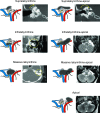Petrous temporal bone cholesteatoma: a new classification and long-term surgical outcomes
- PMID: 18769653
- PMCID: PMC2435479
- DOI: 10.1055/s-2007-991112
Petrous temporal bone cholesteatoma: a new classification and long-term surgical outcomes
Abstract
The goals of this retrospective case review were to analyze the long-term results of surgery for petrous temporal bone cholesteatomas and to propose a new classification system for these lesions. Patients with a surgically confirmed petrous temporal bone cholesteatoma were treated at Addenbrooke's Hospital, a tertiary referral center. Postoperative facial function, hearing, residual/recurrent cholesteatoma, and other complications were assessed in relation to preoperative signs, intraoperative findings, and surgical approach. Between 1983 and 2004, 43 patients were treated. There were no perioperative deaths. There was no long-term recurrence in 95.4% of the patients, possibly because of meticulous surgical technique, bipolar diathermy, and use of the laser to denature the cholesteatoma matrix that was adherent to the dura. At presentation, 95% of the patients had no socially useful hearing in the affected ear. Facial nerve function, however, was usually preserved. Both direct anastomosis and nerve grafting can improve facial nerve function from House-Brackmann grade VI to grade III if the palsy is not longstanding. Four patients had cerebrospinal fluid leakage; other complications were rare. The proposed classification facilitates surgical planning and predicts the postoperative outcome with regards to hearing.
Keywords: Petrosal cholesteatoma classification; hearing.
Figures



References
-
- King T T, Benjamin J C, Morrison A W. Epidermoid and cholesterol cysts in the petrous apex of the petrous bone. Br J Neurosurg. 1989;3:451–461. - PubMed
-
- De Souza C E, Sperling N M, da Costa S S, et al. Congenital cholesteatomas of the cerebropontine angle. Am J Otol. 1989;10:358–363. - PubMed
-
- Axon P R, Fergie N, Saeed S R, Temple R H, Ramsden R T. Petrosal cholesteatoma: management considerations for minimizing morbidity. Am J Otol. 1999;20:505–510. - PubMed
-
- Profant M, Steno J. Petrous apex cholesteatoma. Acta Otolaryngol. 2000;120:164–167. - PubMed
-
- Fisch U. Infratemporal fossa approach for extensive tumors of the temporal bone and base of skull. In: In: Silverstein H, Norell N, editor. Neurological Surgery of the Ear. Birmingham, AL: Aesculapius; 1977. pp. 33–53.
LinkOut - more resources
Full Text Sources
Other Literature Sources

